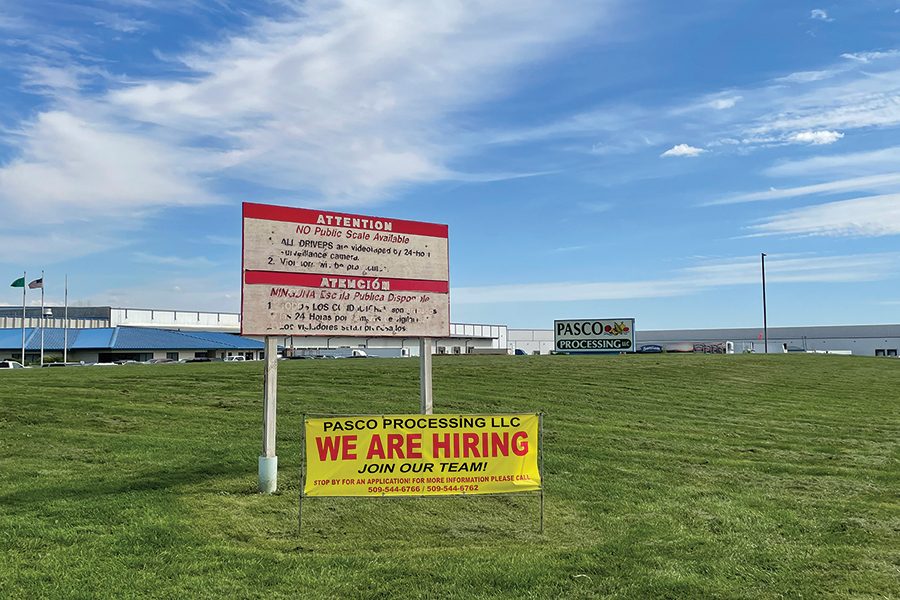
Home » At midyear, Tri-Cities economy is ‘chugging along’
At midyear, Tri-Cities economy is ‘chugging along’

June 14, 2024
At midyear, it appears the Tri-Cities economy is holding steady.
The unemployment rate is up over last year, and the labor market has cooled somewhat. But the numbers are in line with those from pre-Covid-19 – and they’re a good indicator, along with factors such as building activity and population growth, of economic health.
The increasing employment rate “is a change, it’s not what we’re used to in the last three years,” however it’s in line with the 20-year trend, said Ajsa Suljic, a regional labor economist with the Washington State Employment Security Department. “Essentially, we’re going back to pre-pandemic natural economic activities in the labor market.”
Employment numbers
As of April, the state unemployment rate (not seasonally adjusted) was 4.4%, up from 3.5% at the same time last year. The rate for the Kennewick-Richland-Pasco area in April was 4.9%, slightly above the state numbers and up from 4.2% for the Tri-Cities area from April 2023.
It’s not unusual for Tri-Cities’ unemployment to be higher than the state, Suljic said, noting that this region has a more diverse job market with more seasonal labor.
As of April, the Tri-Cities area had about 126,100 nonfarm jobs, ranging from construction and manufacturing to retail, hospitality and government posts.
A few sectors saw particular gains over April 2023, including construction and similar work, which gained 600 jobs; professional and business services, which gained 500 jobs; and education and health services, which added 900 jobs, according to state data.
Other sectors saw losses, including about 900 jobs in manufacturing and 200 jobs each in government and in leisure and hospitality, the state data showed.
Overall, the region saw a net gain of 1,100 nonfarm jobs between April 2023 and 2024.
During the pandemic and post-pandemic, “we had a lot of volatility in the labor market. There was a large increase in unemployment, and then a very quick recovery in regard to labor force demand,” Suljic told the Tri-Cities Area Journal of Business.
Eventually, the labor market tightened as businesses expanded and consumer spending confidence increased demand, she said. But there’s been cooling in recent months.
“Now, we’re going back to a little bit more of a normal operation of business activities,” Suljic said.
‘Chugging along’
The Tri-Cities has some economic pluses specific to the region, said Steve Scranton, a senior vice president and chief economist for Washington Trust Bank.
The presence of employers such as the Hanford nuclear site and Pacific Northwest National Laboratory provide some insulation in the labor market. And during and since the pandemic, the area has benefitted from people moving in, Scranton said.
People have reevaluated their lifestyles and moved away from big cities, and “we’ve seen Eastern Washington as a whole benefit,” and especially the Tri-Cities, he said.
Both Benton and Franklin counties have seen population growth since 2020.
Statewide, a housing shortage and housing affordability problem persists, and in places like the Tri-Cities that still have room for development, construction activity is solid, Scranton said. Permit activity suggests both resident and commercial construction activity in the Tri-Cities are active, he said.
“My basic picture for you, I’d say the Tri-Cities economy has been chugging along, just like the U.S. economy. Even though everybody thought we were going to be at risk of a recession last year, we’ve just discovered that business has been continuing pretty solid,” he said. “And it’s been the case for the Tri-Cities as well.”
Looking ahead
His top concern looking ahead is a “bifurcated economy” where upper wage earners can rely on assets, while lower wage earners rack up debts amid inflation and higher interest rates. It’s a reality even in the Tri-Cities, where a Battelle employee and a hospitality worker, for example, “are having two different experiences with this economy,” he said.
It’s something to keep an eye on in terms of economic outlook, Scranton said.
So is this: “I think the message that I’d give the Tri-Cities and, really, Eastern Washington, is embrace the success of people wanting to come live in your areas” and then be proactive in terms of infrastructure, housing and the like, he said.
“Any economy that wants to continue to grow has to have people keep moving in,” he said. “It’s just figuring out how to do that in an organized and orderly way and be more proactive towards that versus reactive.”
Latest News Economic Outlook
KEYWORDS June 2024
Related Articles




